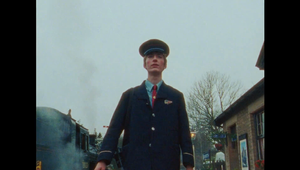
VFX on Film: Crafting Award-Winning Burberry ‘Festive’ and ‘Open Spaces’

There’s a lot to celebrate for Burberry and the team behind two of its most successful films in recent years.
In 2021, Burberry Festive, directed by Riff Raff’s directing quartet MEGAFORCE, won a string of VFX craft awards from the likes of D&AD, Cannes Lions and the Clios, as well as an Immortal award nomination.
And the success didn’t stop there, winning Advertiser of Excellence and Commercial of the Year at the British Arrows 2022, along with gold in the VFX and Fashion & Apparel categories, and silver in the Colourist, Director, Creative Use of Music and Best Over 60 Second Commercial categories.
Not only that, but their follow up spot Open Spaces, won silver in the Fashion & Apparel category, and bronze in the Director and Over 60 Second Commercial categories.
Both films are beautifully crafted on celluloid film, processed and scanned through Cinelab Film & Digital, with subtle VFX work crafted under creative direction from The Mill’s Alex Lovejoy.
To dive deeper into how these incredible works came together, LBB’s Sunna Coleman speaks to the team behind the scenes, who share exactly how VFX on film works, what creative challenges they faced in the making of these spots, and how films on celluloid speak to us on a cerebral level.
LBB> Both Burberry Festive and Open Spaces involved a lot of sophisticated and subtle VFX work on film. Can you tell us about what that process looks like and how something like this is achieved?
Alex> Film is my favourite format to work with! The film scans are in the log colour space, so you know what you are dealing with from the get-go. The motion blur from a film camera has no stepping artefacts that you tend to get with digital cameras, and the film grain and slight softness you get with the image is just beautiful. All ideal for compositing.
Adrian> A real film aesthetic can deliver many benefits to VFX work and the compositing of VFX elements within a frame. Celluloid film contains film grain made up of visible silver crystals in film negative emulsion. These light-sensitive silver halides change into pure metallic silver when exposed to light, which is how an image is captured on celluloid film.
Film grain is uniquely different on every frame. It is this film grain in celluloid film that can lend a subtle softness to edges and this aids the bedding in of VFX work in a beautiful, natural way.
LBB> What are the challenges of crafting VFX on celluloid film? How different is it to creating VFX on digital?
Alex> The biggest challenge is waiting to receive the film scans! This is almost a forgotten art nowadays and very few places in Europe can transfer 35mm film. Once we have the scans our workflow is very similar to that of digital cameras.
Adrian> Walter Murch has a great saying about the film vs digital argument, “A static image on film has the anticipation that something is about to happen, whereas on digital it's over.”
LBB> Tell us about the process of creating both Burberry Festive and Open Spaces. What solutions did you need to come up with?
Alex> The choreography of the dancers in Festive demanded extremely precise timings and placements for the ice blocks. It was essential, as the directors had a strong vision for their behaviour. It was obvious early on that we needed a flexible and scalable approach to place and animate the elements in a real-time environment.
While the interactive placements were central to the story, we also needed methods to populate large areas of the plate in the background whilst maintaining consistency between shots.
For Open Spaces, the invisible VFX was challenging. In particular, painting out the crash pads and removing multiple cranes used to suspend the wire rigs in the forest trees.
After the shoot we went back to the forest to photograph the locations without all the cranes and wire rigs to capture the environment for accurate clean-up.
LBB> What are you most proud of from each project?
Alex> Working with Riff Raff and Megaforce. Their innovation and collaborative process were amazing. Both films are timeless. You can watch them again and again, always finding something new.
In Festive the bullet time ice shot is mega, my favourite shot. And in the forest sequence in Open Spaces, we created half of the forest in CG, specifically placing hero trees to pass close to camera… epic!
LBB> Any other creative insights you would like to share?
Alex> In Festive there is only one practical piece of falling ice. We created over 50,000 ice simulations for the ice storm. Open Spaces has over 3000 frames of invisible VFX, and did you spot the full moon in the opening and end shots?
Adrian> Did you know that celluloid film can help on a more cerebral level? As individuals and as a society, we have developed a sophisticated level of visual understanding that allows us to read imagery. We have developed ‘ways of seeing’.
The look of real, celluloid film is deeply ingrained in our personal visual codecs. When we see an image captured on film, we are more inclined to think of it as ‘real’. We are sold into the concept of a moment captured.
In contrast, we have become attuned to heavily touched-up and manipulated digital imagery. This has led to us developing a distrust of that aesthetic. Therefore, celluloid film plays into our cognitive bias and can help elevate work in ways you wouldn’t expect.















